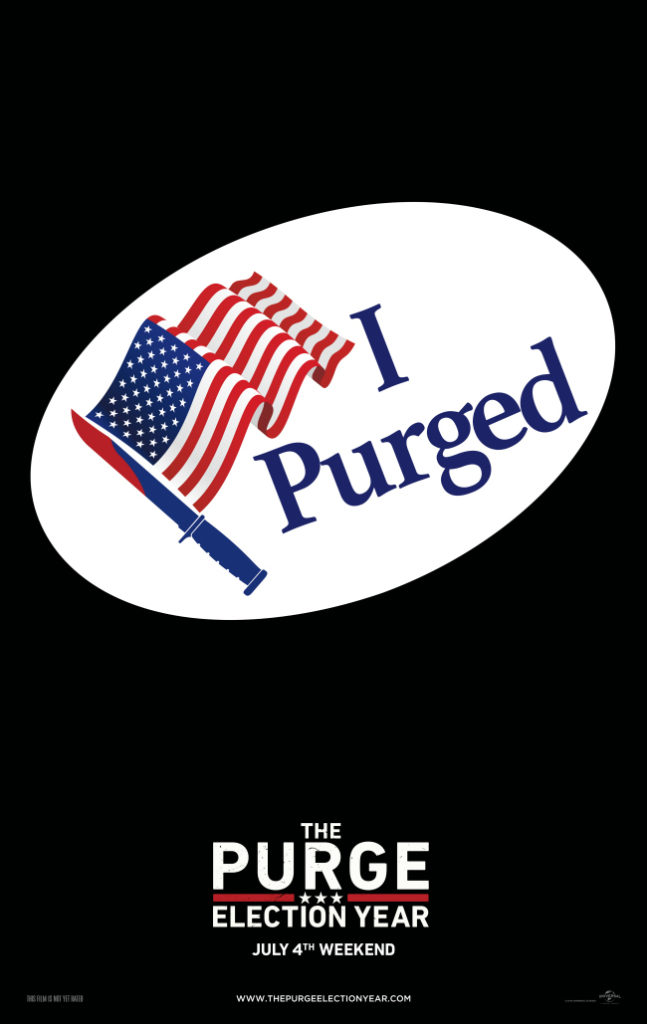 “The Purge: Election Year” is the capper to the trilogy no one saw coming, the third film in a series written and directed by James DeMonaco, and if you’ve been following along since the first movie, then you will be a little surprised to see the scope of this world opened up even more, and now a rather complete picture has been painted in a very visceral manner, with the thematic elements of class warfare and wealth inequality become the driving force behind an insane premise for a movie, let alone three of them.
“The Purge: Election Year” is the capper to the trilogy no one saw coming, the third film in a series written and directed by James DeMonaco, and if you’ve been following along since the first movie, then you will be a little surprised to see the scope of this world opened up even more, and now a rather complete picture has been painted in a very visceral manner, with the thematic elements of class warfare and wealth inequality become the driving force behind an insane premise for a movie, let alone three of them.
The basic premise was barely laid out in the first movie, in which Ethan Hawke played a guy who installed security systems in the homes of people who could afford to barricade themselves up during Purge Night, the one night of the year in which all crime is legal for 12 hours, in an effort to let people “get it out of their systems” so that they would be cool to each other for the other 8,748 hours of the years. His character quickly discovered even his family wasn’t safe, as a bunch of psychopaths broke into their home and terrorized them all. The second movie drops this character and picks up with a new guy, who was going to use Purge Night to kill the guy who DUI-manslaughtered his son, but instead wound up saving people out on the streets and not going through with the murder. In this second movie, it is explained that people suspect the Purge was a tool by the government to eliminate the impoverished portions of their constituency.
Now in “The Purge: Election Year,” that guy is back – Leo Barnes (Frank Grillo) is now the head of security for independent presidential candidate Senator Roan (Elizabeth Mitchell), a populist politician who promises to make her first act as president the elimination of the Purge, which is now fully realized by many as the tool of the ruling political class to eliminate poor people so that the government can save money on things like entitlement programs and public housing and whatnot. Basically with less people in the world, there are less people to share with, less people out there who may dare to want to take part in the American Dream despite not fitting a particular “profile.” And the political ruling class who benefit from the Purge in a number of ways decide to use this Purge night to assassinate Senator Roan so that they can retain political power and keep their status quo going.
So most of the movie is Leo trying to keep the Senator safe, but there is also a parallel storyline about Joe the Deli Owner (Mykelti Williamson) and how his Purge insurance went up by thousands of dollars the day before the Purge, so he feels he has no choice but to protect his business that night. Along with his lone employee, they keep an eye on the place with guns ready and while doing their thing, they see Leo and the Senator and decide to help them, bringing the stories together. There is another new detail of Purge night that gets introduced here, and that is how some people volunteer to ride around the city in a reinforced ambulance and provide medical service to people on the street, and of course one of these volunteers is a friend of Joe and a total reformed bad ass named Laney (Betty Gabriel) and she quickly becomes the face a person wants to see when the shit hits the fan because she knows how to survive. And then they also show the underground resistance introduced in the second movie, showing their base of operations, and they get heavily involved in the plot as the movie goes on, including their leader Dante Bishop (Edwin Hodge), and Dante and the Senator even have some quick debates about his violent resistance tactics and the best way to move forward to stop this madness.
Stuff like these debates about the effectiveness of their particular resistance are what makes this movie a little smarter than it would appear to be at the outset. When you hear the premise, it just sounds like sound high concept bullshit excuse to make a violent movie, but with the second two of these three films, there is more here than just crazy costumes and violence. There is actual thought put into this stuff, a throughline of class warfare that actually makes the movie resonate more than just as a typical horror film. The only problem is that these movies have very little subtlety in these themes, and instead of alluding to these things and making them the subtext of the movie, it is all just text, all the characters are literally just walking around saying what the movie is about and what their character’s philosophies are about the Purge, as this movie is loaded with the soft grace of a sledgehammer slamming into concrete. As such, while the movie is smarter than it would seem, it is also a little dumber than it wants to be. A strange middle ground to be in, but there you have it.
Also I think it is worth noting that the racial identity politics of “The Purge: Anarchy” might be the only thing that the characters don’t actually speak about, leaving it up to the viewer to pick up on these albeit not-so-subtle clues about what this movie represents. It is no mistake that the political party in this movie, the New Founding Fathers, are a fictionalized version of the Republican political party. Like our real world Republicans, the NFF wants to reduce government services to the poor and needy and make sure that the rich and wealthy are super-served in this country through their political machinations. And when we see a ridiculously shadowy and overly evil NFF meeting, something like 8 out of ten people in that boardroom were men, and they were all white. When these heads of the NFF meet later on in the movie with a few dozen of their fellow party members, they are all white as well. And when they hire a gang of mercenaries to take out the Senator, they hire a group of white supremacists who roll around with swastikas and Confederate flags emblazoned on their uniforms.
As a matter of fact, the only non-evil white people in this movie are Leo and the Senator, and that is because Leo saw the error of his ways and is reformed while the Senator saw her family die during the Purge so she has ultimate empathy for the victims of the Purge because she was one of them. They are the awakened heroes among the sleeping masses who see the reality of the Purge and what terror it brings to everyone, so that is why they are not onboard with this program. Meanwhile, the resistance is led by a black guy and they consist mostly of black and brown faces, so this movie is a stab at the racial politics in this country and how this us versus them mentality is seemingly becoming stronger than ever, as the ruling power class is seeing a shift in the paradigm of how the masses see them. People are fighting back in this country, on both sides of the political spectrum, and it is getting ugly. Will it get to Purge levels? Likely not. But it still doesn’t look good out there.
Obviously, because of how movies are made, the idea for the overtly political angle of this movie started before the current presidential election season got off to a seemingly goofy start last summer, and it just became serendipity for this movie to now be released in what has turned out to be one of the most insane and nasty presidential campaign years in several decades, with one of the two major political party fielding an openly racist and xenophobic candidate who actively courts white supremacists to his cause, a candidate whom might see the fictional idea of a Purge night as a viable option for the future of our country. Thanks to this insane political climate, this movie actually has more resonance now. Hopefully we won’t be looking back at this in ten years and seeing how “prescient” it actually was, because that would be a bummer.


 #532 – Plant Them Seeds
#532 – Plant Them Seeds Bonus Episode – Oscar Picks 2018
Bonus Episode – Oscar Picks 2018 Review: ‘Run All Night’
Review: ‘Run All Night’ #135 – Dutch Oven Book
#135 – Dutch Oven Book
Leave a Reply
You must be logged in to post a comment.